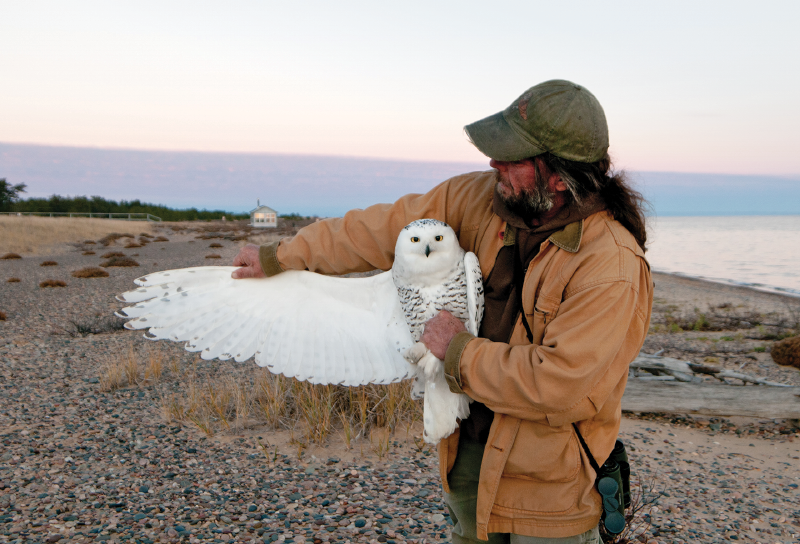
When spring arrives at Whitefish Point, a sandy headland on Lake Superior north of Paradise, a tsunami of birds typically follows. Wave after wave of songbirds, raptors, waterbirds and waterfowl stop at or pass by the point, as they wing their way north during migration.
The peninsula is home to Whitefish Point Light — the oldest lighthouse on Lake Superior — and the popular Great Lakes Shipwreck Museum. But it also is the home for the lesser-known Whitefish Point Bird Observatory, an avian research station that, in recent years, has become a magnet for bird watchers.
Thousands of birders arrive throughout the seasons — some for spring migration, some for fall. More than 300 are expected to show up for WPBO’s annual Spring Fling on April 29-30, a weekend of guided bird walks, workshops about owls, songbird vocalizations and endangered piping plovers, among others.
“It’s kind of the crown jewel of Michigan birding,” said Heather Good, executive director for Michigan Audubon Society, which helped create the observatory in 1979 and took over its operations in 2016. “Because of the location and geography, it (the point) creates a funnel effect for migrating birds and a unique opportunity to study them.”
Avian researchers working there spend their days watching the skies and tallying what flies by or lands. The WPBO hawk count, water bird count and owl-banding efforts have established the area as a major North American birding resource. The Hawk Migration Association of North America (hmana.org) calls it “the most important spring flight corridor for raptors (birds of prey) in North America.” The nonprofit group compiles data from more than 200 hawk watches across the continent. Whitefish Point observers recorded 20,726 raptors in May 2016.
“We want to make Spring Fling more of a family-friendly birding event and one that is more approachable for people with different levels of birding experience.” — Heather Good
WPBO also was designated an Important Bird Area (IBA) in 2007 by the National Audubon Society, the U.S. partner to BirdLife International (birdlife.org), the global bird conservation organization that created the IBA program. IBA designations can be globally, continentally or state significant. Whitefish point IBA is globally significant, according to the U.S. Fish & Wildlife Service. Between 25 and 40 percent of the North American population of Red-necked Grebes annually is observed migrating past.
More than 340 bird species have been seen by birdwatchers at the point. Good says “expert birders are totally on fire about what they see there. There are always new species to be seen.”
Chris Neri, a WPBO field ornithologist and owl bander declares the owl migration is unlike any other. He and Nova MacKently, another owl bander, do much of their work at night when owls fly. In spring, that can entail snowshoeing for miles to retrieve owls from mist nets that are set in the woods to capture them. The owls are fitted with identifying bands and released unharmed. Banding provides researchers with information about their flight patterns and range. Owls banded at Whitefish Point have been observed as far south as Alabama and coastal Virginia and 2,000 miles away in Saskatoon, a city in Saskatchewan, Canada.

“The owl migration we see here is one of a kind and really amazing,” said Neri, a lifelong birder who worked in the 1990s at New Jersey’s Cape May Bird Observatory on the Atlantic Ocean. “The spring owl migration here is by far the largest in North America. We’ve banded over 1,200 owls in spring.”
Whitefish Point visitors can observe owl banding on Friday and Saturday evenings. The facility is open until midnight. Visitors can’t go out to the nets, but they can watch and learn at WPBO headquarters.
Good hopes more people will visit the observatory. It has been well-known among dedicated birders, but Michigan Audubon is working to broaden its appeal, she said.
“It’s had an underground culture feel to it,” Good explained. “You had to really be in the know to enjoy it. But we want people to come and experience Whitefish Point. We want to make Spring Fling more of a family-friendly birding event and one that is more approachable for people with different levels of birding experience.”
Find out more about Whitefish Point Bird Observatory at wpbo.org.
Howard Meyerson is an award-winning journalist and managing editor of Michigan BLUE Magazine.







Facebook Comments